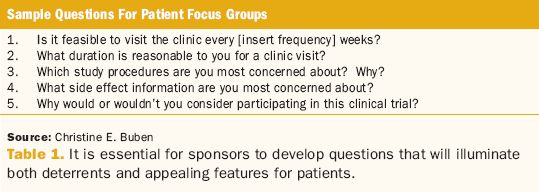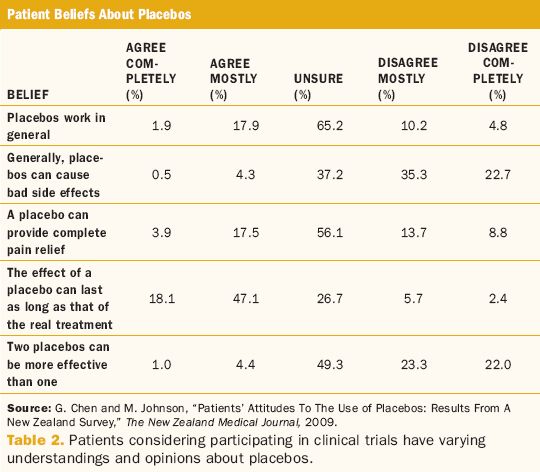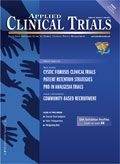Integrating Patient Retention Strategies
Applied Clinical Trials
Addressing patient dropout with an arsenal of tools that leverages both technology and communication.
Patients are motivated to participate in clinical trials for multiple reasons: to contribute to the advancement of medicine, to help others, to earn extra money, and to gain access to a treatment for their disease.1 Additional motivators can include a patient's desire for self-education about treatment options, what the patient read or heard about the study, and a doctor's recommendation.2 Despite these motivators, patient retention is a challenge commonly faced during clinical trials. Poor patient retention can adversely affect a trial by lengthening timelines, adding cost, introducing risk to the interpretation and validity of study data, and delaying product approval.3 Therefore, it has become critical for sponsors and sites to proactively address patient retention in clinical trials. In developing a patient retention plan at the inception of a trial, sponsors should consider creative tactics that can be implemented throughout the life of the trial to mitigate patient retention risks. By adopting a phased approach, patient retention strategies can be integrated into study activities on an ongoing basis and offer a cumulative benefit to the sponsor and sites. Specifically, there are three key stages during which a sponsor can capitalize on patient retention methodologies: the study design phase, the patient consent phase, and the patient participation phase.
Study design phase
A sponsor can initiate a patient retention plan as early as the study design phase of a trial. During protocol development, sponsors should consider how the study design will translate into patient burden for study participants. The number of study visits, complexity of the tasks the patient must perform, and the convenience of the site location can all build into unrealistic patient burden that leads to early discontinuation from the study.1 A proactive strategy to integrate into the study design phase is to conduct focus groups, surveys, or panels with patients similar to those that may enroll in the trial. Although traditionally used as a marketing tool, focus groups can offer the sponsor insights into patient perceptions about the trial. Proper execution of a focus group should consist of recruitment of patients that meet a pre-specified profile (age, gender, diagnosis, and previous experience with clinical trials) comparable to patients that may be approached for study enrollment. Participant feedback can be optimized by ensuring a small size (eight to 12 participants per group) and using an experienced moderator to facilitate questions.4 When engaging in this approach, it is essential for the sponsor to develop questions that will illuminate both deterrents and appealing features for patients (Table 1). While initiating, conducting, and evaluating focus groups can take up to two weeks, this patient-centric tactic can define for the sponsor critical patient perceptions of study burden, questions potential patients will ask about the study, areas of concern for the patient, and why patients would be motivated to participate. This upfront information can be utilized to modify aspects of the study design undesirable to patients (if possible) and to prepare investigators to address patient needs specific to the study throughout the conduct of the trial.5 The study investigator meeting is a prime opportunity to present the outcomes of patient focus groups and prepare study site teams for concerns that patients may have. The investigator meeting can also provide an interactive forum for site staff to exchange successful strategies for addressing patient concerns.

Patient consent phase
As the study lifecycle evolves from the study design phase to patient recruitment, the sponsor has another opportunity to integrate patient retention into study operations. At the time a patient consents to participate in a clinical trial, the consent process features a detailed explanation of what will occur during the conduct of the study, risks and benefits, and potential side effects. To mitigate retention risks at this time, it is valuable to use investigator-driven education to address potential patient misconceptions about receipt of a placebo, insurance, and standard of care.6
As some patients that enroll in trials decide to withdraw later because of concerns about being on a placebo, the investigator can play a key role at the time of consent to ensure that patients are educated about placebos and concerns about receiving a placebo alleviated. It is crucial for study sites to recognize that patients considering participating in clinical trials have varying understandings and opinions about placebos. Table 2 demonstrates varying patient opinions about placebos garnered from a survey of over 200 patients.7 During the patient consent phase of a trial, patient education about placebos can be built into study operations across all sites as part of the overall patient retention plan for the study. This educational effort can be further enhanced by creating a DVD or podcast for patient viewing during the consent process.

Patient participation phase
As the patient consent phase concludes and patients are actively participating in a study, the sponsor can implement additional patient retention methodologies to keep retention efforts active as the study moves forward. At this juncture, strategies should transition from informational to needs-based. When the sponsor and sites conduct the study with the study participant's needs in mind, patient retention can be enhanced. Study participants have communicated common needs: to feel like they are taking control of their disease, to feel respected and connected with the study staff, and to know that their participation has an impact.8
When building needs-based retention strategies into study operations at the patient participation phase, tactics for maintaining strong communication with the patient over extended periods of time during the trial are essential. Some study sites have utilized the traditional mode of telephone contacts to engage with patients between clinic visits. Sponsors should also consider the alternative of a low-cost technology solution to enhance patient communication which leverages the SMS functionality of cell phones. This strategy involves delivering text messages and alerts directly to the subject via his or her cell phone. The advantages of this strategy are that it is easy to implement, confidential, and provides a direct communication pathway between the investigator and the patient. In addition to re-enforcing timing of upcoming clinic visits, medication compliance, and utilization of patient diaries, this strategy can be leveraged for making the patient feel valued and important. While it is critical for sponsors using this technology to comply with all applicable regulations for data protection and collection, this tool combined with other retention strategies can strengthen the connection between the investigator and the study patient.9 This tactic can be paired with social media as another avenue that can be incorporated into the retention plan for a study. Mobile phone apps, Twitter, and study-specific Facebook pages can be capitalized on to share study updates and keep patients connected with the study staff. While these tactics require thoughtful implementation to ensure compliance with regulatory guidelines and company legal practices, they can provide a study participant with a powerful tool to get real-time information.10
Even though technology solutions can provide a supportive role in retention during the patient participation phase, ensuring the patient has a positive experience at the clinical trial site remains critical for ongoing patient participation. After examining patient management strategies in a large Phase III trial for multiple sclerosis, a sponsor determined that sites that assessed and discussed their patients' emotional status (i.e., feelings and attitudes toward participation) had lower rates of early discontinuation of treatment. Specifically, the sites that were most effective at retaining patients consistently promoted the importance of the patient's contribution to research, ensured personal attention by the investigator during unscheduled visits, and established realistic expectations for treatment risks and benefits.11 Another sponsor selected the mid-point of a study to send a letter to each patient from a respected key opinion leader or physician associated with local media. The content of the letter updated the patient on the status of the trial and expressed appreciation for the patient's ongoing participation and overall contribution to research in the applicable disease.
The patient retention plan at the patient participation phase can be further enhanced by offering items to patients that reflect their needs as study patients. Experience from the Extremity Constraint-Induced Therapy Evaluation (EXCITE) study, a rehabilitation clinical trial, demonstrated the application of this strategy by providing each patient with a personal notebook containing a calendar of their clinic visits, a copy of their signed informed consent, contact information for study staff, and a letter of appreciation—tools to complement feelings patients have when they wish to be active players in their treatment plans. An educational newsletter was provided on a monthly basis to maintain contact with the patients and provide them with information about stroke education, nutrition, and stress reduction. This strategy was also complemented by the utilization of holiday and birthday cards to build relationships with patients.12 The utilization of retention gifts, however, has been debated among industry professionals. TREAD Research, a site-management organization based at Tygerberg Hospital in the Republic of South Africa, recently examined the effectiveness of utilizing retention gifts in clinical trials. Approximately 300 study subjects participating in several of the SMO's ongoing trials were asked to complete a questionnaire about receipt of retention gifts during participation in a trial. The study found that receipt of gifts alone did not motivate a patient to stay involved with a trial, however, it was important to making the patient feel appreciated. The utilization of retention gifts is not new, but should be considered as part of a sponsor's arsenal given the strategy's benefits.3
As a sponsor develops a patient retention plan for a study, pre-established checkpoints should be identified to ensure sites and the sponsor partner together for a routine assessment of patient satisfaction with their experience as clinical trial subjects and the overall effectiveness of patient retention tactics already integrated into the study. The assessment process can take on various forms and should be tailored to ease of use and efficiency in the clinical trial setting. The main benefit from this strategy is that specific sources of patient dissatisfaction can be addressed before patients decide to withdraw participation and the sponsor can get feedback on the retention efforts made during the study to date.13
Conclusion
Patient motivation for participation in clinical trials is multi-factorial. The sponsor study team, however, can effectively attack the problem of patient dropouts with an arsenal of tools that leverages both technology and communication to reduce risk and optimize outcomes. While a one-size-fits-all approach is not feasible for all indications, a sponsor can integrate patient retention activities into site operations over the life of the study starting at the study design phase and continuing on through the patient participation phase. With this approach, patient retention activities occur on an ongoing basis and the sponsor can maximize on multiple opportunities to prevent dropouts.
Christine E. Buben, MS, MBA, is a drug development leader with expertise in operationalizing protocols, e-mail: [email protected].
References
1. D. Engfer, "Retaining Subjects Is Harder Than Recruiting Them," Applied Clinical Trials, (2004), http://bit.ly/1750udE.
2. H. Taylor, "The Many Reasons Why People Do (and Would) Participate in Clinical Trials," Harris Interactive Health Care News, 10 (3) 1-5 (2003).
3. L. J. Burgess and N. U. Sulzer, "Patient Retention Gifts in Clinical Trials—Undue Inducement or Justified Motivational Tools?" South African Medical Journal, 101 (9) 640-641 (2011).
4. R. Barbour, "The Use of Focus Groups to Define Patient Needs," Journal of Pediatric Gastroenterology & Nutrition, 28 (4) S19-S22 (1999).
5. L. Moench, "Putting Patients First," Applied Clinical Trials, (2010), http://bit.ly/Zeog1K.
6. P. Smith-Marshall, "Recruitment Strategies: A European Perspective," Applied Clinical Trials, (2006), http://bit.ly/133bqEv.
7. G. Chen and M. Johnson, "Patients' Attitudes To The Use of Placebos: Results From A New Zealand Survey," The New Zealand Medical Journal 122 (1296) 35-46 (2009).
8. K. Getz, "Conversations With Study Volunteers," Applied Clinical Trials, (2010), http://bit.ly/11pgG0W.
9. T. Davis and P. Hughes, "Text TRIAL to 85342 to Receive More Details," Applied Clinical Trials, (2008), http://bit.ly/16psF7x.
10. T. Kaplan, "The Role of Social Media in Clinical Trial Recruitment," Applied Clinical Trials, (2010), http://bit.ly/ZezYcJ
11. D. Mohr, D. Goodkin, L. Masuoka, L. Dick, D. Russo, J. Eckhardt, A. Boudewyn, and L. Bedell, "Treatment Adherence and Patient Retention in the First Year of a Phase-III Clinical Trial for the Treatment of Multiple Sclerosis," Multiple Sclerosis, 5 (3) 192-197 (1999).
12. S. Blanton, D. M. Morris, M. G. Prettyman, K. McCullogh, S. Redmond, K. E. Light, and S. L. Wolf, "Lessons Learned in Participant Recruitment and Retention: The EXCITE Trial," Phys Ther, 86 (11) 1520-1533. (2006).
13. D. Anderson, A Guide to Patient Recruitment and Retention, (CenterWatch, Boston, 2004).
